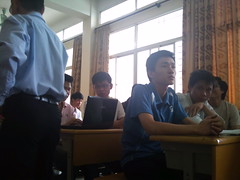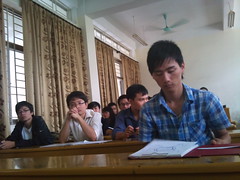Từ những năm 90, Apple nằm ở phân khúc máy tính cá nhân giá cao hơn
hẳn so với PC sử dụng Windows.
Cho tới năm 2011, sản phẩm của Apple vẫn được coi là đắt so với các hãng khác.
Hệ thống logistics và mạng lưới bán hàng là một điểm mấu chốt của
Apple giúp họ giảm time-to-market.
Innovation giúp Apple luôn giữ fan trung thành.
Kết hợp với nhà mạng đưa ra những "plan" nhiều năm (2-5 năm) và điều
kiện về số lượng dữ liệu sử dụng, số tiền tối thiểu sử dụng hàng háng
giúp Apple lên dần vào phân khúc điện thoại (và sau này có thể là
table) giá rẻ hơn.
http://www.nytimes.com/2011/10/24/technology/apples-lower-prices-are-all-part-of-the-plan.html?_r=1&pagewanted=print
Apple's Lower Prices Are All Part of the Plan
By NICK WINGFIELD
Something unexpected has happened at Apple, once known as the tech
industry's high-price leader. Over the last several years it began
beating rivals on price.
People who wanted the latest Apple smartphone, the iPhone 4S, were
able to get one the day it went on sale if they were willing to wait
in a line, spend at least $199 and commit to a two-year wireless
service contract with a carrier.
Or they could have skipped the lines and bought one of the latest
iPhone rivals from an Apple competitor, as long as they were willing
to dig deeper into their wallets. For $300 and a two-year contract,
gadget lovers could have picked up Motorola's Droid Bionic from
Verizon Wireless, or they could bought the $230 Samsung Galaxy SII and
$260 HTC Amaze 4G, both from T-Mobile, under the same terms.
Apple's new pricing strategy is a big change from the 1990s, when
consumers regarded Apple as a producer of overpriced tech baubles,
unable to compete effectively with its Macintosh family of computers
against the far cheaper Windows PCs. But more recently, it began using
its growing manufacturing scale and logistics prowess to deliver Apple
products at far more aggressive prices, which in turn gave it more
power to influence pricing industrywide.
Apple's innovations — including products like the iPhone, iPad and the
ultrathin MacBook Air notebook — are justifiably credited for their
role in the company's resurgence under its chief executive and
co-founder, Steven P. Jobs, who died on Oct. 5. But analysts and
industry executives say Apple's pricing is an overlooked part of its
ability to find a large audience for those products beyond hard-core
Apple fans. Apple sold more than four million iPhone 4S smartphone
over its debut weekend.
People can still easily find less expensive alternatives, with less
distinctive and refined designs, to most Apple products. Within the
premium product categories where Apple is most at home though,
comparable devices often do no better than match or slightly undercut
Apple's prices. "They're not cheap, but I don't think they're viewed
as high-priced anymore," said Stewart Alsop, a longtime venture
capitalist in San Francisco.
Apple declined to comment for this article.
Prices in the ultrathin notebook category are an illustration of
Apple's strategy. While there are much cheaper laptops for sale,
ranging all the way down to bargain-basement netbooks that cost a few
hundred dollars, Apple's MacBook Air has become a hit among computer
users seeking the thinnest and lightest notebooks available. The
product starts at $999 for a model with an 11-inch screen.
On Oct. 11, the Taiwanese computer maker Asus introduced its answer to
the MacBook Air, a sleek device that uses Windows. But it was unable
to undercut Apple; the Asus computer also starts at $999. Samsung's
wafer-thin Series 9 notebook, with comparable features, costs $1,049.
The computer maker Acer, however, began undercutting the cheapest
MacBook Air this month with an $899 ultrathin notebook, the Aspire S
series, that has a bigger screen.
The original MacBook Air catered to a more rarefied audience when it
came out in early 2008, priced at a whopping $1,799 for a model with a
13-inch screen. A year ago Apple revamped the notebook to make it
thinner and smaller and reduced its entry-level prices to $999 and
$1,299 for models with 11-inch and 13-inch screens. Jean-Louis Gassée,
a venture capitalist and former Apple executive, said there was a
"collective gasp" at how low Apple priced the new MacBook Air.
The aggressive pricing, analysts say, reflects Apple's ability to use
its growing manufacturing scale to push down costs for the crucial
parts that make up its devices. Apple has also shown a willingness to
tap into its huge war chest — $82 billion in cash and marketable
securities last quarter — to take big gambles by locking up supplies
of parts for years, as it did in 2005 when it struck a five-year,
$1.25 billion deal with manufacturers to secure flash memory chips for
its iPods and other devices.
By buying up manufacturing capacity ahead of time, Apple forces its
competitors to scramble for the parts that are still available,
raising costs for their products, analysts say. Apple is the biggest
buyer of flash memory chips in the world, according to the research
firm iSuppli.
Mr. Gassée said Apple's pricing decision on the MacBook Air made it
clear that Apple's management of its supply chain had become a
"strategic weapon."
Another example of that was Apple's decision to price the entry-level
iPad at $499 when it was introduced early last year, hundreds of
dollars lower than many analysts expected. "I think everyone was
stunned at the cost of the iPad," said John Gallaugher, an associate
professor of information systems at Boston College. "It was a very
competitively priced device."
For a time, Apple's biggest competitors were unable to go below the
iPad's price with their own tablets. When Motorola Mobility Holding's
Xoom tablet hit the market in February, the cheapest model available
without a wireless service contract was $800. Motorola later released
an entry-level model with more storage than the least expensive iPad,
priced at $599.
After lackluster sales, Apple's major competitors are now finally
undercutting the iPad on price, though it is not clear how sustainable
that approach is. Motorola recently announced a plan to offer an
entry-level Xoom tablet for $379 at Best Buy stores for a limited
time. After Hewlett-Packard, having missed sales goals, announced
plans to discontinue its TouchPad line of tablets, it dropped the
price of its cheapest model to a fire-sale $99.
The most credible challenge to the iPad is likely to come from
Amazon's $199 Kindle Fire tablet, which goes on sale in November.
While analysts say they believe Amazon will lose money on each device
sold, the Internet retailer's plan is to use the device to encourage
purchases of other Amazon products and services, like e-books. Toni
Sacconaghi, an analyst at Sanford C. Bernstein & Company, said the
price of the iPad reflected a "mind-set change" at Apple after the
introduction of the first iPhone in 2007, which started at $499. That
was an eye-popping sum for a phone in markets like the United States,
where people had become accustomed to getting lower-price,
carrier-subsidized phones in exchange for committing to long wireless
contracts.
Only a few months after the product went on sale, Apple cut $200 off
the price of the high-end model of the iPhone, to $399. Apple shifted
gears again in 2008 with a new model called the iPhone 3G that it
priced at $199, after beginning to accept handset subsidies from its
carrier partners, something it did not do with its first version of
the phone. Carriers pay Apple more for the latest iPhones — around
$600 each, analysts estimate — aiming to profit by locking consumers
into wireless plans.
Mr. Sacconaghi said Apple's pricing of the original iPhone and its
exclusive distribution deal with AT&T in the United States at the time
created an opening for Google and its handset partners to flood the
market with phones running its Android operating system.
While Apple's iPhone business is thriving, Android handsets accounted
for 43.4 percent of the worldwide smartphone market in the second
quarter, compared with 18.2 percent for Apple, the research firm
Gartner estimates.
Many carriers now offer older Android handsets that cost customers
nothing if they sign up for two-year contracts. And now even Apple is
getting into that act: when it announced its latest iPhone model this
month, it said its two-year-old iPhone 3GS would be free with a
two-year contract.


